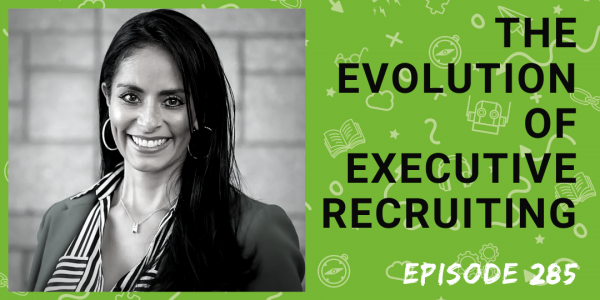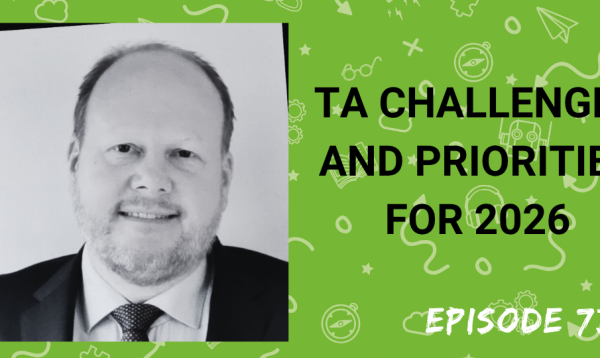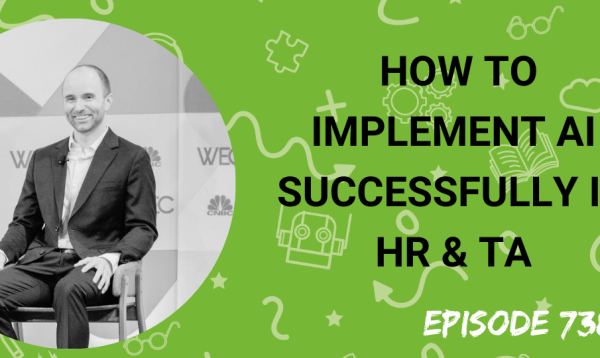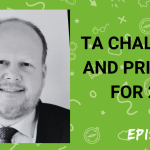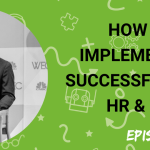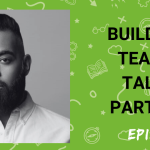Executive recruiting has always been seen as somewhat separate to the rest of talent acquisition. Search firms have traditionally dominated the market, and digital transformation in this area has historically been very slow. However, a growing number of employers now have their own in house executive recruiting functions and the COVID 19 pandemic is changing everything.
My guest this week is Adriana Quevedo, Director of Executive Search and On-Boarding at Intel. Adriana has spent the last eight years helping to develop in house executive recruiting at Intel and has some great insights and advice to share.
In the interview with discuss:
• The challenges of executive recruiting
• How Intel’s in house function has evolved, and the lessons learnt
• Advice on setting up an in house function
• The importance of benchmarking and networking with industry peers
• Dramatically reducing reliance on search firms.
• Combining science and art to secure the right hires
• How COVID 19 is effecting executive recruiting and onboarding
• Providing a white glove experience virtually
• Diversity and Inclusion
• What’s next for executive recruiting at Intel
Subscribe to this podcast in Apple Podcasts
Transcript:
Matt Alder [00:00:00]:
Support for this podcast comes from E6. E6 advances corporate executive recruiting by providing its 90 plus members with proprietary research, tools, training and the networking they need for a competitive advantage. Members include the likes of BT Group, Philips, booking.com, mondelez, American Express, and Walmart. You can find out more@e6.org and E6 is spelled E S I X E6 new book Leadership Strategies, Tactics and Tools for Hiring Organizations releases on Amazon in December. The book not only shows how great companies recruit great leaders, it reveals the history and best practices of this vital and sometimes secretive function. To get your copy, send your questions on corporate executive recruiting to Simon6.org and say Matt Alder sent you the best questions. Will receive a free copy.
Matt Alder [00:01:26]:
This is Matt Alder. Welcome to episode 285 of the Recruiting Future podcast. Executive recruiting has always been seen as somewhat separate to the rest of talent acquisition. Search firms have traditionally dominated the market and digital transformation in this area has historically been very slow. However, a growing number of employers now have their own in house executive recruiting functions and the COVID 19 pandemic is changing everything. My guest this week is Adriana Quevedo, Director of Executive Search and Onboarding at Intel. Adriana has spent the last eight years helping to develop in house executive recruiting at intel and has some great insights and advice to share.
Matt Alder [00:02:18]:
Hi Adriana and welcome to the podcast.
Adriana Quevedo [00:02:21]:
Thank you so much. Thank you for having me here today.
Matt Alder [00:02:24]:
An absolute pleasure to have you on the show. Could you just introduce yourself and tell everyone what you do?
Adriana Quevedo [00:02:31]:
Yeah, of course. I’m Adriana Quevedo. I am a proud Latina born and raised in Costa Rica. I currently reside in Arizona. I’m an industrial engineer by education, but definitely a passionate executive search leader and I’ve been with intel for around 23 years in multiple roles and most recently leading the Intel’s executive search team.
Matt Alder [00:02:58]:
Fantastic stuff and we’re going to talk.
Matt Alder [00:02:59]:
A lot about executive search in our conversation.
Matt Alder [00:03:02]:
Before we do though, just give us.
Matt Alder [00:03:04]:
A little bit more insight into your story. How did you end up where you are now?
Adriana Quevedo [00:03:08]:
Good question. Well, you know, I started in the operational part of intel with doing new products introductions and you know as an industrial engineer you oversee multiple areas of the company. So I started to get involved more and more into the people systems arena and then one day I said to myself, so why not doing staffing right? There was an opportunity to manage the Latin American staffing for Intel. And I jump into that one and I love it. And I’ve been doing staffing since then, so it’s been pretty much, I would say, half of my career I’ve been in hr. Half of my career I’ve been doing industrial engineering type of work. But yes, love the human resources area for sure.
Matt Alder [00:04:00]:
Tell us a little bit about the recruiting challenges that you have at Intel.
Adriana Quevedo [00:04:06]:
Yes, definitely. Executive search is an interesting challenge, Right.
Adriana Quevedo [00:04:11]:
But in a good way. Right. Searching for the right candidate, I would say that takes the right strategy, creativity and IT exercises or your skills. Right.
Adriana Quevedo [00:04:24]:
In trying to attract and recruit in all those candidates. So when you get a leader higher, I would say that it’s because all your stars have a line. That’s the way I see it. Right. So I can mention a few challenges that we have seen in the past or through the years. Definitely market availability, right. There is when we’re trying to find a specific candidate, sometimes very niche skills. Right.
Adriana Quevedo [00:04:53]:
There’s not too many people in the market who can actually do the job. Right.
Adriana Quevedo [00:04:58]:
And that would also fit into the company’s culture. So definitely the market becomes smaller and smaller if you start adding on top of that diversity, which is another challenge for us. Right. So we want to make sure that we present diversity in all our slates. And when you do that, when you start trying to find or search for females or search for unrepresented minorities, then obviously your pool of candidates becomes smaller. The other part that I would say that it’s always interesting is the relocation part. Right. Sometimes candidates do not want to explore opportunities because they don’t want to relocate. They don’t want to move for personal reasons, for whatever reasons. But now in the COVID days, definitely it has brought a different perspective, right. Because now companies are becoming more and more flexible regarding location. The other part I would say is tenure. Right?
Adriana Quevedo [00:06:07]:
There are people that are happy in their jobs and don’t want to move. There are people that we call them lifers that have been in the company for a long time and they just have too much invested in that company. So there’s nothing you can offer them in order for them to consider a change. And obviously the last one that I would like to mention, it would be compensation. Right?
Adriana Quevedo [00:06:39]:
Compensation. It is not a surprise that some of these candidates make insane amounts of money. So it’s difficult for a company to attract them or to come up with an attractive offer in terms of salary and in terms of stocks. So this can definitely be a deal Breaker.
Matt Alder [00:06:58]:
Obviously there’ll be lots of employers listening who don’t currently do executive recruiting in house.
Matt Alder [00:07:07]:
Tell us a little bit about what.
Matt Alder [00:07:09]:
The executive recruiting team at intel do and the level that you work up to.
Adriana Quevedo [00:07:14]:
So at intel, our mission is pretty much to connect those industry leaders with our intel opportunities. Right.
Adriana Quevedo [00:07:25]:
And what we try to do is that we do these in a proactive way by networking, by trying to understand what are people currently doing and what are their career aspirations. But also we do it on a requisition based on a more reactive way. Right. Our scope involves directors, senior directors, vice presidents, as well as all the technical ladder, which includes principal engineers, fellows, senior fellows. So it’s pretty comprehensive.
Matt Alder [00:07:59]:
You said you’ve been with the team since it started.
Matt Alder [00:08:04]:
How did it evolve and what have.
Matt Alder [00:08:06]:
Your sort of key learnings been as the team’s built over the years?
Adriana Quevedo [00:08:11]:
Yes, well, I have been doing executive recruiting pretty much through the last eight years. So we started with a very small team and the team has evolved through time. The volume has also quadrupled in time and we are working now. Our working model focuses on three different areas. So the first one I would say it is more related to market research and sourcing and this area is more candidate facing. So this area will focus on industry mapping, doing market intelligence, understanding competition. Right. Doing proactive sourcing and screenings, candidates as well. Then we have the recruiting arm, which this arm is pretty much customer facing. They would do all the engagement with the managers, they would do all the requisition management. We are now introducing candidate assessments for the selection process. So they are also managing that part, the recruiters and then obviously the offer development and delivery. And the last focus area, it is the candidate experience. So in this part of the business we focus on the candidate interview scheduling, all the travel logistics. Then they also help us with all the assessment scheduling in here. We also coordinate all the networking events that we usually do with leaders and they’re also now owning the onboarding part. So we do make sure that the candidate is ready to start within the first day. As I mentioned before, the team has been evolving through these last eight years. Right. Now I would say that our team is very solid, composed of experienced members and we have been able to build the right capabilities and reputation within the company. So after so many years of working together, there are definitely some key learnings that I would like to share. The first one is that it’s obvious that every case is different, right? Every case is unique and that’s why it’s super important that when you’re meeting with your leaders that you should set up clear expectations since the beginning in terms of timeline, in terms of what they should expect, in terms of quality, service candidates, et cetera. So it’s super important so they can understand how long the process will take. Then we have learned as well that having fun while we work hard, it’s important to celebrate those wins. Right? Because as I, as I said before, finding an executive at this level, it’s definitely a hard job and all your stars have to align. So once we get someone in the company, we would definitely celebrate it. Getting some quick wins. It’s important to build relationships with your leaders you’re working with so that you can build trust with them. So having those quick wins can help you build those relationships and getting your leaders to trust you even more. The other one I want to mention is you have to constantly demonstrate value otherwise your leaders will find value externally. And it’s something that we are constantly making sure that we provide the right level of communication, that we make sure that we are providing constant updates on the progress. So that part is very important. We say as well that customer obsession is a priority. As I was saying before, White glove service consistent execution, we should also have some level of flexibility in this world. Obviously we do not control people’s schedules, so we need to work around people’s schedules and have that level of flexibility to make sure that everybody’s happy. Proactive sourcing is super critical and engaging with leaders in networking activities and it definitely takes time and it takes a lot of effort, but the return on the investment is really, really enormous. It is critical as well to get your leaders feedback for continuous improvement. We always say that we want to continuously raise the bar and through the leaders feedback it is that we are able to continue to improve our process and make them more user friendly for sure. The internal partnership with HR as well with business HR is critical because they are the ones that have access to the business. And obviously the partnership that you can develop with your business leader is also critical because at the end they are going to see that you are providing a strategic value to their processes. The benchmark as well has been critical for us. We are constantly benchmarking with other companies and understanding what other companies are doing. E6, for example, has been a great way of me to find my partners in the industry and to have that open communication with them and seeing what are they doing better that we can copy from them. So having those lines of communication is definitely critical to continue raising that bar. And we say that our success criteria. It is definitely when your leaders need to hire internally and externally and you as a recruiter are in their speed dialogue, they can just you are a phone call away. They call you or they text you and you’re available to help them in whatever they need. So that’s when we say we have built the right level of trust and that they want you as part of their discussions and that you have a seat at the table.
Matt Alder [00:15:01]:
So tell us about the tools and techniques you use.
Adriana Quevedo [00:15:03]:
In terms of tools. We use a lot of LinkedIn, of course, we do a lot of referrals for sure. Those are one of our most important sources of information. We do a lot of networking as well with candidates. So as part of the proactive activities, we also search, do a lot of research on competition, on conferences that are going on. Right.
Adriana Quevedo [00:15:33]:
Which are those keynote speakers. So there’s a lot of research that we do. And once or before a candidate starts as well with intel, we try to get as many referrals as possible from them. And we also try to work with our leaders to do some what we call the whiteboard meetings, which is pretty much mapping the market and understanding who do they have in their networks and who do they want us to go after. So we have a very good proactive sourcing strategies that help us identifying candidates ahead of time and in order for us to keep them warm and have them ready for when we need them.
Matt Alder [00:16:16]:
And do you work with any search firms at all or have you have you sort of replaced them with the in house resource that you have in.
Adriana Quevedo [00:16:24]:
Terms of search firms, I think that more and more companies are moving away from executive search firms. For us, the cost of using a search frame for every BP hire, it is around eight times the cost of making use of our internal resources. So it definitely becomes expensive. We use them usually on 5 to 8% of our requisitions on a yearly basis. And yes, my personal opinion is probably that it is beneficial to keep a good relationship with a few of them in case you need additional support. But definitely our internal recruiters have become so good at IT and at understanding what our managers want that definitely they are seeing the value that we can provide to the company.
Matt Alder [00:17:21]:
And what role does technology play in what you do?
Adriana Quevedo [00:17:24]:
We know that technology continues to evolve and disrupt industries. Right. And more and more companies are now identifying technology solutions or developing their own applications. Right. To make sure that their processes are more efficient. These type of technologies definitely help a lot when you are managing high volume recruiting. But in my mind Executive search is more like an art. And why I say this, I say this because when you’re trying to attract senior executive, you require a lot of handholding and you need to do white glove services pretty much to make a difference in attraction, in recruiting, in assessing those senior candidates. Just recently, intel implemented an artificial intelligence tool to search and to match candidates to our open requisitions or positions. And we in Executive Search, we are keeping an eye obviously on how artificial intelligence can be integrated into our searches. And this tool can definitely match talent to the hard skills and identify potential candidates. But definitely there is a big gap that we see in executive search and it is when we need to qualify candidates for specific subskills like communication, like time management, like leadership skills, right? So definitely that verification of mastering those soft skills that you see in resumes or that you see in profiles will require some level of consultation from a recruiter, from a human perspective, right? So it is when interviews and assessments and all the work that executive recruiters do will help verify those skills with the candidates. So definitely, as I said at the beginning, artificial intelligence and automation can help us quickly sort and find potential candidates. But the true determination of those skills needs to be judged or needs to be assessed through the different methods that I just mentioned.
Matt Alder [00:20:02]:
You mentioned the importance of candidate experience and a white glove service in terms of persuading people to move and join the organization. How has the COVID 19 pandemic changed things in terms of the way that you recruit, assess and onboard people?
Adriana Quevedo [00:20:22]:
Yeah, that’s an interesting question. COVID 19 has definitely changed everybody’s life, right? And we will definitely be able to tell a story on how was our life before and after Covid. Right. I see a lot of my friends in Facebook saying, I remember when or we used to go here or we used to do these and that, right? So it’s definitely a historic event. In our case in Executive Search at Intel, we have seen a sense of caution from candidates about making a move right now, right. Everybody’s obviously nervous, right, about the instability, right? But particularly because candidates won’t have a chance to meet anyone from the team in person, right. Or come to the site and see the facility. So I think that that is one of the things that it’s more difficult that you’re gonna be interviewed by phone or you’re gonna be inter by video, right? So we’re doing all of our screenings and interviews through video, webex or Zoom or any tool available, but we still hear concerns from candidates that are not being interviewed face to Face they feel that it makes it harder, right, to get a job. We also have our coordinators and our recruiters making sure that all those screenings or interviews get connected on time so they are there at the start of the interview and ensuring all participants are connected and that they have good quality audio. So we’re investing additional time in there. Obviously, recruiters are doing an extra effort to stay connected with candidates and to stay connected with our interleaders and providing regular progress updates to make sure that everybody’s connected. What else? We are also evaluating the impact on having a flexible work location or permanent working from home policies. So we’re being more flexible in terms of relocation timelines if a job requires you to move to the West Coast. So we are allowing broadly a longer transition for this move to to take place. And obviously for the onboarding, we have created a virtual i9 process, right, to make sure that all the new hires start with it, that do not start without it. And we also have coordinators making sure that the candidates or the new hires have all the requirements to start that first day with regards to the tools, the computers, the phones, the accounts, the network accounts, and obviously access to all the different applications for them to be able to be on the orientation or integration since the first day. Definitely we have invested more in following up, we have done more connections, we have provided constant communication. I want to say that we are seeing probably a faster hiring process just because we are not coordinating the in person interviews. So I think that the logistics are a little bit more efficient in that sense. But definitely the face to face interaction is always beneficial.
Matt Alder [00:24:15]:
So it’s completely impossible to accurately predict the future at the moment with so much uncertainty still around.
Matt Alder [00:24:24]:
But what’s going to be your key.
Matt Alder [00:24:25]:
Focus over the next 18 to 24 months? What are you going to be innovating? What are you going to be focusing on?
Adriana Quevedo [00:24:32]:
For intel, diversity is our number one priority. Although we have achieved U.S. representation or representation in the United States, our CEO wants us to continue focusing for the next 10 years in increasing our global female representation. So now the goal is not only us, it’s going to be global in which our female representation, it’s definitely going to be increased. And then obviously on a US level, we’re also going to be working on the underrepresented minorities leadership at the leadership levels. So we want to pretty much duplicate our current numbers for the Latinos, Hispanics and African Americans and American Indians. Definitely we’re going to be making a lot of efforts there for the next 10 years. It’s going to be a journey for sure. We’re also working on the implementation of leadership assessments for a better position and culture fit, and we are redesigning our interview process to make it more structure. So that’s taking place as we speak. We’re doing now pilots with the Korn Ferry assessment for all our BP levels, all our BP positions, and we plan to have it fully implemented towards the end of the year. Then, due to Covid limitations, we also we’ll need to figure out how are we going to continue doing our leadership networking events. For us, these events were key in order to connect our leaders to industry leaders. So we will definitely need to continue doing it probably on a more online basis, but we will need to define those processes. This is critical for us because it is how we develop those relationships on a proactive way and how we put as well new people in the eyes of our intel leaders. So it’s something that we’re also working on. And the last item I want to mention as well, it is that our executive recruiters will become true talent advisors. And what I mean by that, it is that they are going to be recruiting inside of intel and outside of Intel. So they’re not only going to be focused outside, but they’re going to also recruit our leaders internally and they’re going to be putting the best slates of candidates in front of managers. So it’s going to be a very comprehensive approach in the sense that we are going to be supporting the internal development for our leaders and at the same time we are going to be overlooking the market and comparing both internal and external talent. So it’s it’s going to become very interesting.
Matt Alder [00:27:53]:
Adriana, thank you very much for talking to me.
Adriana Quevedo [00:27:55]:
You’re welcome. Glad to be here.
Matt Alder [00:27:58]:
My thanks to Adriana. You can subscribe to this podcast in Apple Podcasts on Spotify or via your podcasting app of choice. Please also follow us on Instagram. You can find the show by searching for Recruiting Future. You can search through all the past episodes@recruitingfuture.com on that site. You can also subscribe to the mailing list to get the inside track about everything that’s coming up on the podcast. Thanks very much for listening. I’ll be back next time and I hope you’ll join me.

